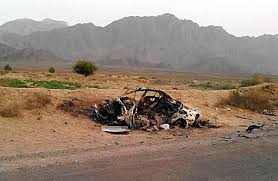
(Credit: wsj.com)
While U.S. surveillance drones don’t operate in the area, intercepted communications and other types of intelligence allowed the spy agencies to track their target as he crossed the frontier on Saturday, got into a white Toyota Corolla and made his way by road through Pakistan’s Balochistan province, according to U.S. officials briefed on the operation.
Then, the U.S. military took over. Operators waited for the right moment to send armed drones across the Afghan border to “fix” on the car and made sure no other vehicles were in the way so they could “finish” the target, the officials said, using the argot of drone killing—all before Mullah Mansour could reach the crowded city of Quetta, where a strike would have been more complicated.
The ambush that killed Mullah Mansour marked a critical moment in Obama administration policy on Afghanistan, as it weighed a push for peace talks and a potential need for a military escalation. It also represented a message to Pakistan that the U.S. would take action on Pakistani soil if necessary without advance warning.
Pakistan’s Interior Minister, Chaudhry Nisar Ali Khan, warned on Tuesday that the strike would have “serious implications” for relations with the U.S. and described the incident as “completely against the U.N. Charter and international law.”
President Barack Obama secretly ordered the strike on Mullah Mansour after first trying to bring him to the negotiating table. Initially, there was hope in Washington that Mullah Mansour would be more open to negotiations than his predecessor, Mullah Mohammad Omar.
Obama administration officials were divided over whether the Pakistanis were capable or willing to deliver Mullah Mansour for the negotiations.
U.S. officials said the Pakistanis tried and grew frustrated in February by Mullah Mansour’s refusal to send representatives to meet with the Afghan government.
Around the same time, people who maintain contacts with the Taliban began to report that Mullah Mansour had left Pakistan and was spending time in Iran.
U.S. intelligence agencies received information that allowed them to track Mullah Mansour’s movements, including details about devices he used for communications, U.S. officials said.
That allowed the spy agencies to present policy makers with a choice: If and when Mullah Mansour were located in Pakistan, should the U.S. strike?
Mullah Mansour’s travels made it easier to find him. In contrast, the Central Intelligence Agency spent years looking in vain for an opportunity to kill the reclusive cleric he replaced, Mullah Omar.
An April 19 Taliban attack in Kabul targeted Afghanistan’s secret service, killing more than 60 people and underlining for the Americans the extent to which Mullah Mansour had chosen a military course. A decision was made that he should “face the consequences” of his refusal to negotiate, a senior administration official said.
The U.S. knew the route Mullah Mansour took to Quetta because he had taken it several times. U.S. intelligence agencies detected his preparations to cross the border back into Pakistan last week.
“Such actionable intelligence is rare,” another senior administration official said. “Given the preponderance of what has happened over the last few months, most principals around the table were going to be hard pressed to say: ‘Don’t take the shot.’”
Both the U.S. military and the CIA operate drones in the region. Military drones in Afghanistan rarely stray across the border, and CIA drones generally only go into Pakistan for strikes in what are known as Federally Administered Tribal Areas, according to U.S. officials. Pakistan facilitates the program by clearing the airspace there for CIA drones, while publicly opposing U.S. strikes in Pakistani territory, they said.
But Balochistan has long been off limits to the drones, U.S. and Pakistani officials say. So U.S. officials believe that Mullah Mansour and other Taliban leaders felt more comfortable there.
Route N-40, which Mullah Mansour and his driver used, cuts between Taftan on the Iranian border and Quetta, the provincial capital of Balochistan, according to the U.S. officials.
The U.S. normally would want multiple drones to keep eyes on such an important target. Because CIA drones weren’t operating in the area, U.S. spy agencies relied on signals intelligence and other location information to track the Corolla’s journey, according to U.S. officials.
Armed drones based in Afghanistan and piloted by the U.S. military’s Joint Special Operations Command were preparing to move in for the kill, the officials said.
The U.S. knew Pakistani radar could detect the intrusion. Pakistan might then scramble jet fighters to intercept the drones, so timing was critical.
The military’s Reaper drones crossed the border into Pakistani airspace, flying low over the mountains along the Afghanistan-Pakistan border to exploit gaps in radar coverage, the officials said.
Officers in the U.S. military command center overseeing the operation held off briefly because the vehicle pulled over near unidentified buildings, the officials said. It’s not clear why the stop was made.
They waited until the car got back on the road and away from other vehicles and buildings. Then they launched the strike, and two Hellfire missiles took out Mullah Mansour, the officials said.
The drones hovered overhead to ensure there were no survivors, then headed back to Afghanistan, the officials said.
The U.S. government agencies involved in the operation agreed in advance that the strike would be disclosed publicly by the Pentagon once completed. The agreement also called for officials to be vague about identifying the location of the strike, and the Pentagon was instructed to announce that the strike took place along the Afghanistan-Pakistan border. But U.S. officials soon disclosed the location inside Pakistan.
Pakistani officials said they weren’t notified by U.S. authorities until seven hours after the strike.
—Margherita Stancati, Saeed Shah, Gordon Lubold and Qasim Nauman contributed to this article.
